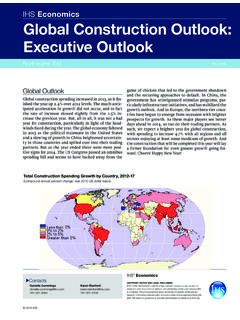Transcription of AUSTRALIA - OECD.org
1 3. DEVELOPMENTS IN INDIVIDUAL OECD AND SELECTED NON-MEMBER ECONOMIESOECD ECONOMIC outlook , VOLUME 2016 ISSUE 2 OECD 2016 PRELIMINARY VERSION105 AUSTRALIAE conomic growth is projected to pick up to 3% by 2018. The decline in resource-sectorinvestment will tail off and the non-resource sector will be supported by a steadyincrease in household consumption and investment as wages and employment falls in unemployment will help reduce inequality and are not expected togenerate strong inflationary policy tightening is expected to commence towards the end of 2017 andthis is appropriate given likely monetary-policy developments elsewhere, the cyclicaldevelopment of the domestic economy and the need to unwind tensions from thelow-interest environment, notably in the housing market, which has in many placesexperienced rising prices for some time.
2 The government envisages fiscal the event of disappointing growth, however, fiscal rather than monetary supportshould play the leading role given the housing-market concerns and fiscal leeway. Taxreform should be a core element of structural is space for fiscal loosening given the low public-debt burden. Returns wouldbe high for accelerated infrastructure development and investing in skills, an area whereAustralia falls short of top-performing countries. Active measures to increase transfersto households could help address inequality, thereby making the recovery towards non-resource sectors continuesGlobal iron ore and, especially, coal prices have risen, and new liquefied-natural-gas(LNG) production is coming on stream. Nevertheless, resource-sector investment andemployment continue to decline.
3 Non-resource output and employment, assisted bycurrency depreciation, continues to strengthen, notably services exports. However,non-resource investment has yet to pick up. House prices and mortgage credit continue toAustralia1. Weighted average of eight capital :Australian Bureau of Statistics; Reserve Bank of 2 2009Q2 = 1009095100105110115120 Index 2009Q2 = 100 Mining sector investment (nominal)Commodity pricesService export volumeAdjustment in the wake of low commodity pricescontinues2009201020112012201320142 015 100110120130140150160170180190 Index 2009Q1 = 100 AUSTRALIA SydneyMelbourneHouse prices remain highdespite the recent slowdown3. DEVELOPMENTS IN INDIVIDUAL OECD AND SELECTED NON-MEMBER ECONOMIESOECD ECONOMIC outlook , VOLUME 2016 ISSUE 2 OECD 2016 PRELIMINARY VERSION106grow, though macro-prudential tightening has recently helped lessen the pace of price inflation remains policy support for economic adjustment and productivity growth isrequiredIn August 2016, the Reserve Bank decreased its policy rate by 25 basis points to ,the second reduction in 12 months.
4 No further easing is projected, and rate increases areprojected to begin towards the end of 2017 as spare capacity fades. Fiscal consolidation ofaround percentage point of GDP is projected, as envisaged by the government. Despitethe employment of macro-prudential measures to cool the housing market, the net gainfrom monetary easing has narrowed. Significant housing market concerns remain andthere is growing discord between financial market developments and rest of the economydue to the low-interest-rate debt has risen but from a low level and the debt-to-GDP ratio,currently around 45%, is projected to begin to fall. There is already fiscal space to respondto an unanticipated downturn in activity. There is room for spending increases, notably anacceleration in the public investment programmes underway in telecommunications,roads and public transport.
5 Demand, output and prices1 2 prices AUD billion GDP at market prices1 Private consumption Government consumption Gross fixed capital formation Final domestic demand1 Stockbuilding1 Total domestic demand1 Exports of goods and services Imports of goods and services Net exports1- Memorandum itemsGDP deflator Consumer price index Private consumption deflator Unemployment rate Household saving ratio, net2 General government financial balance3 General government gross debt3 Current account balance3 1.
6 Contributions to changes in real GDP, actual amount in the first column. 2. As a percentage of disposable income. 3. As a percentage of GDP. Source: OECD Economic outlook 100 database. Percentage changes, volume(2013/2014 prices)3. DEVELOPMENTS IN INDIVIDUAL OECD AND SELECTED NON-MEMBER ECONOMIESOECD ECONOMIC outlook , VOLUME 2016 ISSUE 2 OECD 2016 PRELIMINARY VERSION107 Boosting productivity and combatting exclusion remain important structuralchallenges. Implementation of theNational Innovation and Science Agenda,awiderangingpackage to boost innovation, continues. Also, some tax reforms are underway, notablyefforts to better target pension ( superannuation ) taxation by assisting low-incomeearners and lowering taxpayer support for retirement accounts.
7 Reductions in corporatetax rates are also proposed. However, the reforms fall short of a major shift in taxation asrecommended inOECD Economic Surveys, which stress the importance of efficient tax bases,such as the Goods and Services Tax and land tax. In the greenhouse-gas-reduction policyarea, a welcome safeguard mechanism has begun operating that discourages firms fromoffsetting emission reductions achieved via the Emission Reduction gradual pick-up in growth with sizeable uncertaintiesOutput growth is projected to strengthen to about 3% by 2018. LNG production willboost exports and negative effects from shrinking mining investment will towards non-mining sectors will drive a gradual pick-up of overall activity,helped by supportive macroeconomic policies. Employment growth should result in afurther decline in the unemployment rate.
8 Household consumption growth is expected toremain solid, aided by further downward adjustment in the household saving ratio to thehistorical average. The pick-up in aggregate demand is not projected to generatesignificant inflationary pressure, due to remaining economic has experienced 25 years without recession, but there are risks lookingforward. Commodity market developments, particularly those linked to the Chineseeconomy, remain an important source of uncertainty and risk. Domestically, non-resourceinvestment may remain lacklustre, damping growth prospects. Also, the housing marketremains a risk, as an acceleration in price adjustment would weaken consumptiondemand and construction activity.
















